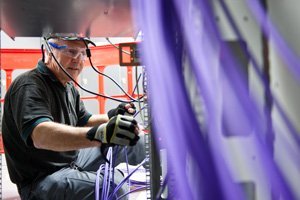
NATS is the UK’s leading provider of air traffic control services. Each year it handles 2.2 million flights and 220 million passengers in UK airspace with an average of 6000 flights over UK airspace each day.
In addition to providing services to 14 UK airports including Heathrow, the world’s busiest dual runway airport, and managing all upper airspace in the UK, NATS works in more than 30 countries around the world spanning Europe, the Middle East, Asia and North America.
NATS prides itself on delivering a safe and efficient air traffic service every day in the UK. This involves managing some of the most complex airspaces in the world.
NATS was established as a national body within the UK in 1962 and in 2001 became a Public/Private Partnership (PPP). This new model of ownership led to more investment (over £2bn since the PPP), which in turn has driven an improvement in NATS’ safety performance, operational efficiency and output through continued innovation. A major part of NATS business is to provide air traffic control services in the UK.
The experience and expertise of its highly trained workforce are critical to solving the multitude of challenges faced by the aviation industry around the world. Air traffic does not rest or sleep, so the company operates 24 hours a day, 365 days of the year, including Christmas Day.
Market Challenges

The world of Air Traffic Management (ATM) is undergoing unprecedented change and the next few years will set the future for the industry. These changes will compel NATS to transform the way it provides ATM services to its customers. In doing so, there will be opportunities to enable the commercial growth of the business, driving NATS ambition ‘to become the acknowledged global leader in innovative air traffic solutions and airport performance.’ Anticipating the evolving priorities of each customer and responding rapidly with services focusing on their needs will differentiate NATS from its competitors, making it the world leader it aspires to be.
Unfortunately NATS is not alone in understanding this. Many industries have had to face similar challenges and our competitors are also aware of this coming change in the industry. In short, NATS business is being shaped by the external market place more than ever before. These market place challenges form a backdrop to the Single European Sky (SES), a policy initiative of the European Commission, which proposes a package of measures covering everything from passenger safety, environmental protection, technological advances, traffic flow management and cost efficiency.
Collectively these measures and concepts will enable Europe to cope with rising air traffic, but will fundamentally change the way air traffic is managed, increase competition and reduce the dependence on nationally bound Air Navigation Service Providers (ANSPs) like NATS. Across European airspace, there are approximately 28 ANSP’s similar to NATS. The primary difference between NATS and other ANSPs is that National Governments own ANSPs in Europe. NATS is owned by a partnership between the Government and other shareholders. That makes NATS very unique in the world.
To address emerging marketplace challenges, implement the concepts that will deliver SES and SESAR (the technological strand of SES) and respond to future opportunities to grow, NATS will need to become more agile and flexible. Ensuring that NATS business, its workforce and its supporting technological infrastructure meet the future needs of the industry and the challenges it faces is its number one priority.
Deploying SESAR and Change in NATS

As discussed, deploying SESAR (the Single European Sky ATM Research programme) concepts, which introduces new methods of managing air traffic, is a critical part of the Single European Sky initiative. The UK government are obliged to adopt many SESAR concepts by law.
A core element of SESAR is about moving to what we term ‘trajectory-based operations’. The current method of Air Traffic Control is to fly along pre-defined airways. These airways have been defined by historic navigation aid locations, with airlines filing flight plans to indicate where they want to fly, referencing these navigation aids. Whilst airborne and following their proposed flight plan, an Air Traffic Controller then uses tactical interventions as appropriate to ensure that two aircraft don’t end up in the same place at the same time. Whilst this helps us to ensure safety, it doesn’t always enable us to deliver all the fuel and environmental benefits our customers want to see.
Introducing the SESAR concept of trajectory-based operations will help to change this. The concept of trajectory-based operations is best explained by imagining a tunnel in the sky from departure all the way to the destination. By increasing the data we receive from aircraft and developing new systems and tools that enable us to process and understand that data, we will be able to create a much more accurate and dynamic picture of an aircraft’s journey from a departure point to a destination.
This will enable us to work out where each aircraft is going to be at what time and then to de-conflict aircraft trajectories before they take off. It will also enable us to work out the most efficient route available, helping to provide those fuel and environmental savings that our customers are seeking. As well as helping us with the en-route or ‘cruising’ phase of flight, it will also help us to implement new concepts for managing traffic in and around airports, helping us to reduce the use of ‘holding stacks’, which are used to hold aircraft just outside an airport until a slot is available for it to land, and enabling us to reduce the noise impact on local communities.
The benefits to NATS and its customers are significant. However, the challenge is not as simple as it sounds. Over the next five years, NATS will invest approximately £600m in transforming its technological infrastructure to enable the requirements of SESAR. To support this transition NATS has formed a number of strategic partnerships with key market players to support the technological transformation.
In addition to the technology changes, NATS will need to ensure that its employees are ready to take on new ways of working. These changes are very significant and will impact almost all employees in NATS, whether it is changing what they do on a day to day basis or developing new skills to ensure that the organisation can meet its future challenges and expectations, whilst ensuring that the day to day service currently offered remains safe and resilient.
The people dimension is as critical as the technological change impacting the organisation. Ensuring that all employees are equipped, aligned and committed to delivering the necessary changes is a core element of the broader NATS approach to transforming the organisation. Having highly capable leadership and a workforce that is flexible is core to this challenge.

However, the challenge of change is compounded by the make-up of the NATS workforce, with a significant percentage of our existing Air Traffic Controllers and Engineers due to reach retirement age during the period of the Deploying SESAR programme of activity up to 2024. Ensuring that all 4200 employees are engaged in the change, that they understand very clearly what needs to be different and how it needs to be different and ensuring that they are equipped to manage the differences between today and tomorrow, are all vitally important as NATS moves from today’s model of air traffic management to our new ways of working. The workforce demographic represents both a challenge and an opportunity to ensure that core knowledge and skills are retained whilst new knowledge and skills are developed. NATS and its unions are working together to ensure the employee dimension poses no undue risks to the overall change or to day-to-day service provision.
It is understood within the organisation that NATS is about to embark on the most significant transformation in its history. As such, senior leadership in NATS have concluded that an integrated approach to managing change is required, that the changes the organisation is facing cannot just be the sum of its parts, but that this transformation needs to be cohesive, dynamic and iterative and carried out within a clear structure of:
- Planning – knowing where the organisation is going over defined periods of time supported by clear systematic programme management and governance;
- Implementation – ensuring the active engagement of all affected employees to ensure participation, with the outcome of having a motivated workforce supported with the necessary training and development to make the transition successful;
- Control – proactively managing the critical path of change, de-conflicting where necessary and ensuring the right levels of governance and control; and
- Review – ensuring that progress is being measured and monitored, any lessons that are identified are being enshrined in doing things differently next time and that the overall objectives of the change are delivering precisely what is expected.

In preparing to meet future challenges and to remain ahead of the competition, NATS is innovating in how it will deliver ATM services in the future. It recognises that it needs to attract new skills to complement the skills that exist in order to support the organisation growth as its overall demographic evolves. Managing the changes that the organisation will undergo over the next 5-10 years is an exciting chapter in NATS history, with fundamental changes to its underpinning technology and to ways of working that will enable it to better serve its customers in the future,. However, it will only be successful if all aspects of change, people, process and technology are managed both systematically and flexibly. NATS recognises this and invests heavily in equipping all employees with the skills necessary to make the organisation a success. NATS is a forward looking company that is aligning itself to a very exciting, if not challenging future ahead.



